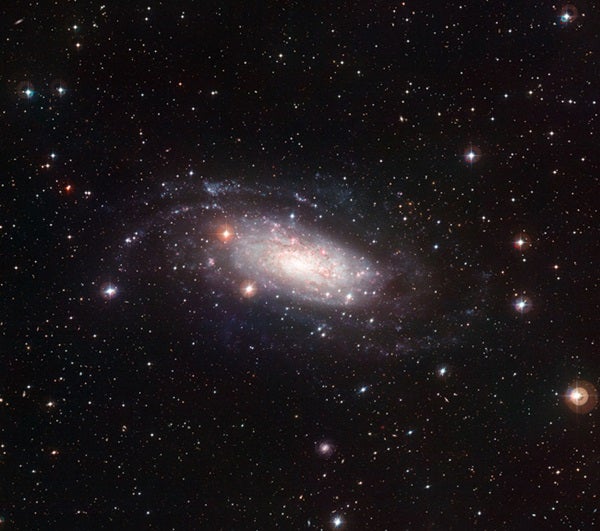NGC 3621 is a spiral galaxy about 22 million light-years away in the constellation Hydra the Water Snake. It is comparatively bright and visible through moderate-sized telescopes. This picture was taken using the Wide Field Imager on the MPG/ESO 2.2-meter telescope at the La Silla Observatory. Joe DePasquale as part of the Hidden Treasures competition selected the data from the ESO archive. Joe’s picture of NGC 3621 was ranked fourth in the competition.
This galaxy has a flat pancake shape, indicating that it hasn’t yet come face to face with another galaxy, as such a galactic collision would have disturbed the thin disk of stars, creating a small bulge in its center. Most astronomers think that galaxies grow by merging with other galaxies in a process called hierarchical galaxy formation. Over time, this should create large bulges in the centers of spirals. Recent research, however, has suggested that bulge-less, or pure-disk, spiral galaxies like NGC 3621 are actually fairly common.
This galaxy is of further interest to astronomers because its relative proximity allows them to study a wide range of astronomical objects within it, including stellar nurseries, dust clouds, and pulsating stars called Cepheid variables, which astronomers use as distance markers in the universe. In the late 1990s, NGC 3621 was one of 18 galaxies selected for a Key Project of the Hubble Space Telescope: to observe Cepheid variables and measure the rate of expansion of the universe to a higher accuracy than had been possible before. In the successful project, 69 Cepheid variables were observed in this galaxy alone.
Multiple monochrome images taken through four different color filters were combined to make this picture. Images taken through a blue filter have been colored blue in the final picture; images through a yellow-green filter are shown as green; and images through a red filter as dark orange. In addition images taken through a filter that isolates the glow of hydrogen gas have been colored red. The total exposure times per filter were 30, 40, 40, and 40 minutes respectively.
NGC 3621 is a spiral galaxy about 22 million light-years away in the constellation Hydra the Water Snake. It is comparatively bright and visible through moderate-sized telescopes. This picture was taken using the Wide Field Imager on the MPG/ESO 2.2-meter telescope at the La Silla Observatory. Joe DePasquale as part of the Hidden Treasures competition selected the data from the ESO archive. Joe’s picture of NGC 3621 was ranked fourth in the competition.
This galaxy has a flat pancake shape, indicating that it hasn’t yet come face to face with another galaxy, as such a galactic collision would have disturbed the thin disk of stars, creating a small bulge in its center. Most astronomers think that galaxies grow by merging with other galaxies in a process called hierarchical galaxy formation. Over time, this should create large bulges in the centers of spirals. Recent research, however, has suggested that bulge-less, or pure-disk, spiral galaxies like NGC 3621 are actually fairly common.
This galaxy is of further interest to astronomers because its relative proximity allows them to study a wide range of astronomical objects within it, including stellar nurseries, dust clouds, and pulsating stars called Cepheid variables, which astronomers use as distance markers in the universe. In the late 1990s, NGC 3621 was one of 18 galaxies selected for a Key Project of the Hubble Space Telescope: to observe Cepheid variables and measure the rate of expansion of the universe to a higher accuracy than had been possible before. In the successful project, 69 Cepheid variables were observed in this galaxy alone.
Multiple monochrome images taken through four different color filters were combined to make this picture. Images taken through a blue filter have been colored blue in the final picture; images through a yellow-green filter are shown as green; and images through a red filter as dark orange. In addition images taken through a filter that isolates the glow of hydrogen gas have been colored red. The total exposure times per filter were 30, 40, 40, and 40 minutes respectively.










